
Apulia, also known by its Italian name Puglia, is a region of Italy, located in the southern peninsular section of the country, bordering the Adriatic Sea to the east, the Strait of Otranto and Ionian Sea to the southeast and the Gulf of Taranto to the south. The region comprises 19,345 square kilometers (7,469 sq mi), and its population is about four million people. It is bordered by the other Italian regions of Molise to the north, Campania to the west, and Basilicata to the southwest. The regional capital is Bari.

Otranto is a coastal town, port and comune in the province of Lecce, in a fertile region once famous for its breed of horses. It is one of I Borghi più belli d'Italia.

Brindisi is a city in the region of Apulia in southern Italy, the former capital of the province of Brindisi, on the coast of the Adriatic Sea. Historically, the city has played an essential role in trade and culture due to its strategic position on the Italian Peninsula and its natural port on the Adriatic Sea. The city remains a major port for trade with Balkan Peninsula, Greece and the Middle East. Its industries include agriculture, chemical works, and the generation of electricity.

Salento, also known as Terra di Otranto, is a cultural, historical and geographic region at the southern end of the administrative region of Apulia, in southern Italy. It is a sub-peninsula of the Italian Peninsula, sometimes described as the "heel" of the Italian "boot". It encompasses the entire administrative area of the Province of Lecce, a large part of the Province of Brindisi and part of that of Taranto.

Negroamaro is a red wine grape variety native to southern Italy. It is grown almost exclusively in Apulia and particularly in Salento, the peninsula which can be visualised as the "heel" of Italy. The grape can produce wines very deep in color. Wines made from Negroamaro tend to be very rustic in character, combining perfume with an earthy bitterness. The grape produces some of the best red wines of Apulia, particularly when blended with the highly scented Malvasia Nera, as in the case of Salice Salentino.
Catherine of Taranto was the daughter of Mary of Enghien and Raimondo Orsini del Balzo di Nola and sister of Giovanni Antonio Orsini del Balzo.

Galatone is a town and comune located in Salento, in the province of Lecce, the former seat of the Marquess of Galatone. It is one of the most populous towns of the province where the Greek dialect Griko is spoken and its territory includes a stretch of coast overlooking the Ionian Sea with the localities of La Reggia and Montagna Spaccata.

Negramaro is an Italian pop band formed in 1999 and successful since 2005. Their name stems from Negroamaro, a wine produced in their native district of Salento in Apulia.
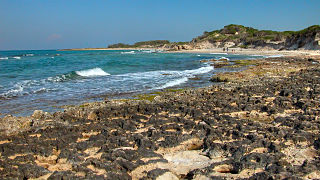
Carovigno is a town and municipality in the province of Brindisi and region of Apulia, in southern Italy. The town of Carovigno has a population of 17,000 residents. Though it is small, it provides a wide array of sites and services that characterize the local life of the town. Being located in upper Salento, Carovigno is renowned for its production of high quality olive oil. Additionally, the city offers several local opportunities for tourists, including its close proximity to the sea, the beautiful landscapes of Apulia, and the cultural depth of Salento.
Villa Castelli is a comune in the province of Brindisi in Apulia, on the south-east Italy coast. It is a comune in Salento, the borderline with Itria Valley. Its main economic activities are tourism and the growing of olives and grapes.
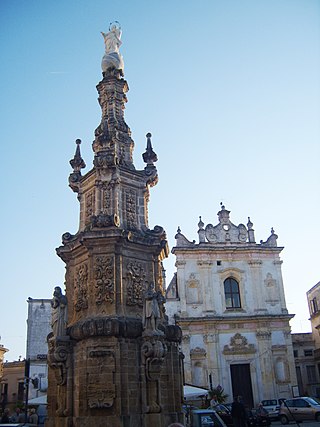
Nardò is a town and comune in the southern Italian region of Apulia, in the Province of Lecce.
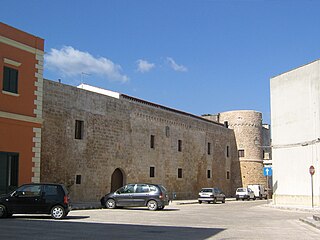
Acquarica del Capo was a town and comune in the province of Lecce, Apulia, south-eastern Italy. In 2019 it was merged with the adjacent Presicce to form Presicce-Acquarica.

Copertino, also known in English as Cupertino, is a town and comune in the province of Lecce in the Apulia region of south-east Italy.
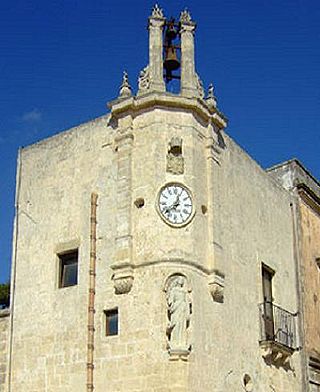
Spongano is a town and comune in the province of Lecce, in the Apulia region of south-east Italy. It is located among the olive groves of Puglia's Salento, and retains its rural character while being just a few minutes to the Adriatic Sea. The rocky shore provides hidden coves interrupted by sandy beaches and reefs. The town bears witness to humanity's prehistoric presence with the dolmen called Piedi Grandi along with other megaliths and mehir.

Taurisano is a town and comune in the province of Lecce, in the Apulia region of south-east Italy. It is located in the Salento area. Nearby towns are Acquarica del Capo, Casarano, Ruffano and Ugento.

Salve is a town and comune of 4,546 inhabitants of the province of Lecce, in the region of Apulia, south-east Italy.

Magliano is a village in Apulia, on the 'heel' of Italy. It is a frazione of the comune of Carmiano in the province of Lecce and has a population of about 2500.
Gianserio Strafella was an Italian Mannerist painter active mainly in Salento. His work may be seen in the chapel of Copertino Castle and the Basilica di Santa Croce in Lecce.
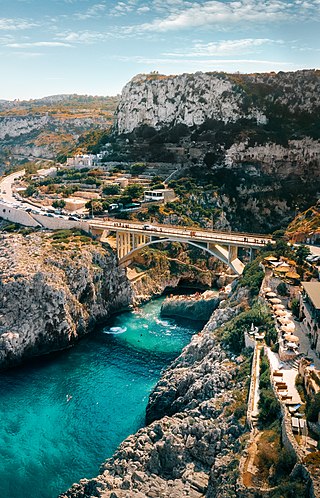
Ciolo is a narrow coastal inlet and a site of historical and environmental interest, which is located in the south of Apulia, in the historical region of Salento, Italy. The location is also known as a geological site and for the presence of numerous sea caves, the largest one being the Grotta del Ciolo. Since October 2006 the Ciolo's area has become part of the Regional Park "Costa Otranto - Santa Maria di Leuca e Bosco di Tricase", created by the Apulia region to protect the eastern coast of Salento, specifically the architectural assets as well as important animal and plant species.
The 1743 Salento earthquake affected the Apulian region of southwestern Italy on 20 February at 23:30 IST. The ~7.1 Mw earthquake had an epicenter in the Adriatic and Ionian seas, off the coast of modern-day Lecce and Brindisi provinces in Salento. It had a maximum Modified Mercalli intensity of IX (Violent), causing heavy damage in Nardò. Damage was also reported across the sea, in the Balkans. The earthquake also generated a tsunami of up to 11 meters in run-up. Between 180 and 300 people were killed in the disaster.
















